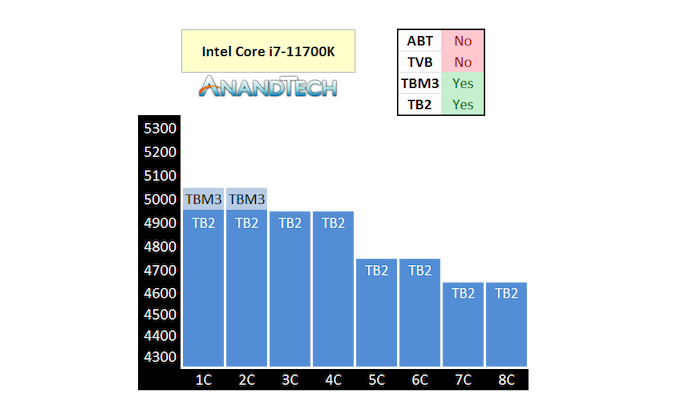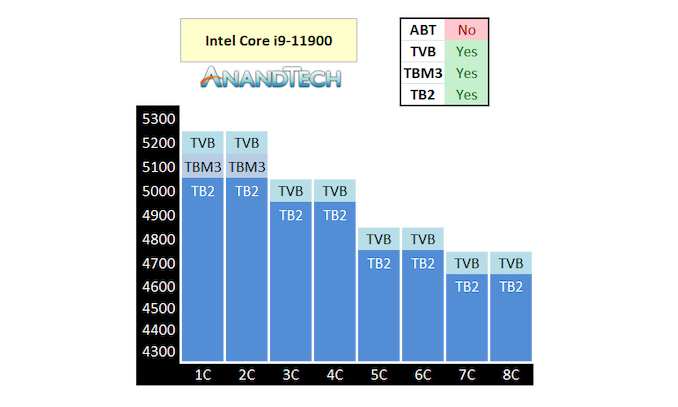Intel Rocket Lake (14nm) Review: Core i9-11900K, Core i7-11700K, and Core i5-11600K
by Dr. Ian Cutress on March 30, 2021 10:03 AM EST- Posted in
- CPUs
- Intel
- LGA1200
- 11th Gen
- Rocket Lake
- Z590
- B560
- Core i9-11900K
Intel’s New Adaptive Boost Technology for Core i9-K/KF
Taken from our news item
To say that Intel’s turbo levels are complicated to understand is somewhat of an understatement. Trying to teach the difference between the turbo levels to those new to measuring processor performance is an art form in of itself. But here’s our handy guide, taken from our article on the subject.
Adaptive Boost Technology is now the fifth frequency metric Intel uses on its high-end enthusiast grade processors, and another element in Intel’s ever complex ‘Turbo’ family of features. Here’s the list, in case we forget one:
| Intel Frequency Levels | ||
| Base Frequency | - | The frequency at which the processor is guaranteed to run under warranty conditions with a power consumption no higher than the TDP rating of the processor. |
| Turbo Boost 2.0 | TB2 | When in a turbo mode, this is the defined frequency the cores will run at. TB2 varies with how many cores are being used. |
| Turbo Boost Max 3.0 | TBM3 'Favored Core' |
When in a turbo mode, for the best cores on the processor (usually one or two), these will get extra frequency when they are the only cores in use. |
| Thermally Velocity Boost | TVB | When in a turbo mode, if the peak thermal temperature detected on the processor is below a given value (70ºC on desktops), then the whole processor will get a frequency boost of +100 MHz. This follows the TB2 frequency tables depending on core loading. |
| Adaptive Boost Technology | ABT 'floating turbo' |
When in a turbo mode, if 3 or more cores are active, the processor will attempt to provide the best frequency within the power budget, regardless of the TB2 frequency table. The limit of this frequency is given by TB2 in 2-core mode. ABT overrides TVB when 3 or more cores are active. |
| *Turbo mode is limited by the turbo power level (PL2) and timing (Tau) of the system. Intel offers recommended guidelines for this, but those guidelines can be overridden (and are routinely ignored) by motherboard manufacturers. Most gaming motherboards will implement an effective ‘infinite’ turbo mode. In this mode, the peak power observed will be the PL2 value. It is worth noting that the 70ºC requirement for TVB is also often ignored, and TVB will be applied whatever the temperature. | ||
Intel provided a slide trying to describe the new ABT, however the diagram is a bit of a mess and doesn’t explain it that well. Here’s the handy AnandTech version.
First up is the Core i7-11700K that AnandTech has already reviewed. This processor has TB2, TBM3, but not TVB or ABT.
The official specifications show that when one to four cores are loaded, when in turbo mode, it will boost to 4.9 GHz. If it is under two cores, the OS will shift the threads onto the favored cores and Turbo Boost Max 3.0 will kick in for 5.0 GHz. More than four core loading will be distributed as above.
On the Core i9-11900, the non-overclocking version, we also get Thermal Velocity Boost which adds another +100 MHz onto every core max turbo, but only if the processor is below 70ºC.
We can see here that the first two cores get both TBM3 (favored core) as well as TVB, which makes those two cores give a bigger jump. In this case, if all eight cores are loaded, the turbo is 4.6 GHz, unless the CPU is under 70ºC, then we get an all-core turbo of 4.7 GHz.
Now move up to the Core i9-11900K or Core i9-11900KF, which are the only two processors with the new floating turbo / Adaptive Boost Technology. Everything beyond two cores changes and TVB no longer applies.
Here we see what looks like a 5.1 GHz all-core turbo, from three cores to eight cores loaded. This is +300 MHz above TVB when all eight cores are loaded. But the reason why I’m calling this a floating turbo is because it is opportunistic.
What this means is that, if all 8 cores are loaded, TB2 means that it will run at 4.7 GHz. If there is power budget and thermal budget, it will attempt 4.8 GHz. If there is more power budget and thermal budget available, it will go to 4.9 GHz, then 5.0 GHz, then 5.1 GHz. The frequency will float as long as it has enough of those budgets to play with, and it will increase/decrease as necessary. This is important as different instructions cause different amounts of power draw and such.
If this sounds familiar, you are not wrong. AMD does the same thing, and they call it Precision Boost 2, and it was introduced in April 2018 with Zen+. AMD applies its floating turbo to all of its processors – Intel is currently limiting floating turbo to only the Core i9-K and Core i9-KF in Core 11th Gen Rocket Lake.
One of the things that we noticed with AMD however is that this floating turbo does increase power draw, especially with AVX/AVX2 workloads. Intel is likely going to see similar increases in power draw. What might be a small saving grace here is that Intel’s frequency jumps are still limited to full 100 MHz steps, whereas AMD can do it on the 25 MHz boundary. This means that Intel has to manage larger steps, and will likely only cross that boundary if it knows it can be maintained for a fixed amount of time. It will be interesting to see if Intel gives the user the ability to change those entry/exit points for Adaptive Boost Technology.
There will be some users who are already familiar with Multi-Core Enhancement / Multi-Core Turbo. This is a feature from some motherboard vendors have, and often enable at default, which lets a processor reach an all-core turbo equal to the single core turbo. That is somewhat similar to ABT, but that was more of a fixed frequency, whereas ABT is a floating turbo design. That being said, some motherboard vendors might still have Multi-Core Enhancement as part of their design anyway, bypassing ABT.
Overall, it’s a performance plus. It makes sense for the users that can also manage the thermals. AMD caught a wind with the feature when it moved to TSMC’s 7nm. I have a feeling that Intel will have to shift to a new manufacturing node to get the best out of ABT, and then we might see the feature on the more mainstream CPUs, as well as becoming default as standard.













279 Comments
View All Comments
macakr - Tuesday, March 30, 2021 - link
really? that bad? I can get that on a 15w Ryzen 4700u!Slash3 - Tuesday, March 30, 2021 - link
The 4700u mobile APU has a much stronger iGPU core, similar to that of Rocket Lake.Alistair - Wednesday, March 31, 2021 - link
Yeah it is that bad. Generally if you keep the resolution at 900p or 720p (or 50 percent scaling of 1080p, which is ~768p) the performance is ok. But it falls off dramatically at 1080p. No linear scaling here. Basically it is MUCH worse than laptop parts. I have DDR3600C16 so was expecting better. Oh well.Runeterra was barely playable at 1440p, just a basic card game, but the FPS shoots up dramatically at 1080p or lower, so that's fine. Would be nice to play Hearthstone and Runeterra with integrated graphics one day...
Tom Sunday - Thursday, April 8, 2021 - link
I am getting on the years and like to finally replacing my 13-year old Dell XPS 730x. Its time after being forced to replacing (3-times) PSU's, Motherboards, AIOs, GPU's and RAM. The new Intel i5 11600K holds interest. Will the 'integrated graphics' be good enough for just browsing the Net and watching old western or war movies on utube and with not doing any gaming? How good is the IGPU in this regard? Once I have more money I can hopefully buy a used discrete GPU 'over the table' next year at the local computer show? Will probably have my new system cobbled together by the local stripcenter PC shop and by one of the Bangladesh boys. So it will be good to sound somewhat intelligent discussing the hardware and not being pushed into what is cheap and in stock that day. Thoughts?Spunjji - Friday, April 9, 2021 - link
The iGPU on Rocket Lake will be fine for those purposes. However, so would the iGPU on the cheaper Comet Lake processors out there - they may be a better (cheap) option if you're going to buy now and upgrade later.Another option would be to go for a system based around the AMD Ryzen 5 3600 and re-use an existing GPU, which would also give you the option to upgrade the CPU again to something like a 5800X or even 5900X later. Personally, I'd go with that approach.
0ldman79 - Friday, April 16, 2021 - link
The integrated GPU is fine for movies and web.I've got a Skylake laptop with GTX 960M, it uses the iGPU until I fire up a game.
The h264 and h265 playback are accelerated through the iGPU, barely draws any power at all for video playback. The screen draws all the power. It'll play back 1080P 60 h264 or h265 all day long at under 2W. There are no issues using it for the web or anything else using integrated, it'll even play some games at lower settings, roughly 1/4 of a 750 Ti (960M) in gaming, though the newer chips will be slightly better.
Alexvrb - Tuesday, March 30, 2021 - link
Vega 11 is actually a bit slower than the latest 8 CU Vega found in Renoir/Cezanne. Not enough to catch up to Iris Xe, I don't think... but impressive given the smaller GPU and same power (or better). That's still GCN, too. If they release an APU with a ~10 CU RDNA2 GPU, it should give them a substantial boost... as long as bandwidth doesn't cripple it. Next gen memory should help, but they might also integrate a chunk of Infinity Cache. It has proven effective on larger RDNA2 siblings, giving them good performance with a relatively narrow memory bus.Oxford Guy - Wednesday, March 31, 2021 - link
Good ole iGPU distraction.How about the most important stuff? How about having it appear on the first page?
• performance per watt
• performance per decibel
Apples-to-apples comparison, which means the same CPU cooler in the same case for Intel and AMD.
That is important, not this obsession over a pointless sort-of GPU.
Jezwinni - Saturday, April 3, 2021 - link
I agree the iGPU is a distraction, but disagree on what declare the important things.Personally the performance for the price is the important thing.
Any extra power draw isn't going to blow up my PSU, make my electricity bills unmanageable, or save the world.
Why you consider the performance per watt most important?
0ldman79 - Friday, April 16, 2021 - link
Performance per watt on iGPU only matters in mobile devices, even then it's barely measurable.The iGPU is only going to pull 10W max, normally they peak around half that.